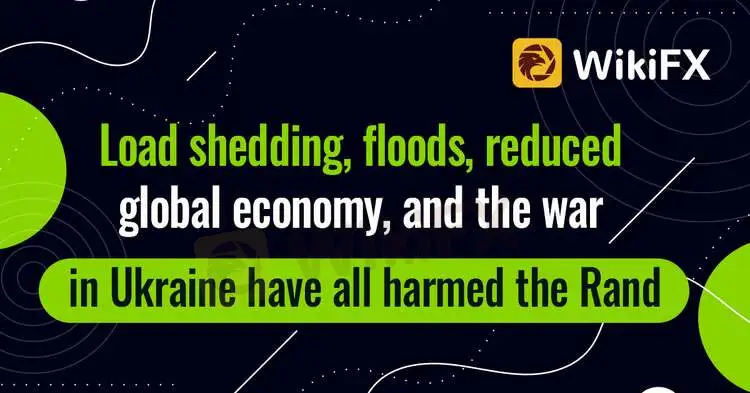简体中文
繁體中文
English
Pусский
日本語
ภาษาไทย
Tiếng Việt
Bahasa Indonesia
Español
हिन्दी
Filippiiniläinen
Français
Deutsch
Português
Türkçe
한국어
العربية
Load shedding, floods, reduced global economy, and the war in Ukraine have all harmed the Rand
Abstract:As a result of the breakdown of two more generating units yesterday, Eskom increased its rotating power cuts to Stage 4, extending load shedding until Friday morning. In the best-case scenario, the power utility predicted 37 days of load shedding, but the worst-case scenario could see the country without electricity for 100 days this winter. Load shedding is expected to cost the South African economy R500 million per stage a day in 2022, as economic activity comes to a halt during power outages.

As a result of the breakdown of two more generating units yesterday, Eskom increased its rotating power cuts to Stage 4, extending load shedding until Friday morning. In the best-case scenario, the power utility predicted 37 days of load shedding, but the worst-case scenario could see the country without electricity for 100 days this winter. Load shedding is expected to cost the South African economy R500 million per stage a day in 2022, as economic activity comes to a halt during power outages.
Eskom reportedly spent R235 million on fuel for 20 open-cycle gas turbine generators to keep the lights on during the long Easter weekend, despite lesser demand, according to reports. Due to fears about the impact of catastrophic power outages and deadly flooding in KwaZulu-Natal, the rand plummeted 0.35 percent to R14.96 to the dollar by 5 p.m., its lowest level since March 20, according to Eskom.
The government has declared a National State of Disaster as a result of the floods, which have killed 443 people, damaged infrastructure worth billions of rands, and interrupted supply networks for essential goods like fuel. During the long weekend, the rand weakened owing to both global and domestic causes, according to Citadel Global head Bianca Botes. The euro has been pushed down by uncertainty around the Ukraine conflict and the potential of quicker Federal Reserve interest rate rises, according to Botes.
“The rand fell to its lowest level versus the dollar since April 7 over the weekend, as Eskom warned of additional power outages this week and severe rainfall and floods in KZN continued to wreak havoc on essential infrastructure, both negatively impacting the country,” Botes said.

“The rand was also pulled down by uncertainty surrounding the Ukraine conflict and the potential of quicker Fed interest rate rises.” The South African Reserve Bank (Sarb) penciled in ongoing monetary policy tightening and an improved economic outlook, which curbed additional losses.
As the situation in Ukraine continues, data from Statistics South Africa is likely to show headline inflation climbing from 5.7 percent in February to 6% in March.South Africa, on the other hand, is in a comparatively robust budgetary situation, having benefited from the spike in commodities prices brought on by the Covid-19 supply interruptions and the crisis in Ukraine.
However, the Russia-Ukraine conflict has harmed global economic development, prompting a series of downward adjustments as the outlook for the lengthy geopolitical conflict has worsened.Due to the conflict in Ukraine, the IMF cut its global growth forecasts for 2022 by 0.8 percentage points to 3.6 percent.According to the IMF, this reflects the direct impact of the crisis in Ukraine and sanctions on Russia, both of which are expected to have sharp contractions.
It forecasted 5.7 percent inflation in advanced countries and 8.7 percent in emerging market and developing economies, respectively, 1.8 and 2.8 percentage points higher than in January. The IMF's economic growth prediction for South Africa has stayed constant since January, at 1.9 percent for 2022 and 1.4 percent for 2023, in line with Sarb projections.

Disclaimer:
The views in this article only represent the author's personal views, and do not constitute investment advice on this platform. This platform does not guarantee the accuracy, completeness and timeliness of the information in the article, and will not be liable for any loss caused by the use of or reliance on the information in the article.
Related broker
Read more

The Impact of Interest Rate Decisions on the Forex Market
Interest rate changes determine currency attractiveness, influencing capital flows and exchange rate trends. Understanding this mechanism helps investors navigate the forex market effectively.

How a Housewife Lost RM288,235 in a Facebook Investment Scam
A 47-year-old housewife in Malaysia recently fell victim to an online investment scam, losing a substantial sum of RM288,235 after engaging with a fraudulent scheme advertised on Facebook.

Interactive Brokers Launches Forecast Contracts in Canada for Market Predictions
Interactive Brokers introduces Forecast Contracts in Canada, enabling investors to trade on economic, political, and climate outcomes. Manage risk with ease.

Bank Negara Malaysia Flags 12 New Companies for Unauthorised Activity
Bank Negara Malaysia (BNM) has updated its Financial Consumer Alert List (FCA List) by adding 12 more entities, reinforcing its efforts to warn the public against unregulated financial schemes. Check if your broker made the list!
WikiFX Broker
Latest News
The Withdrawal Trap: How Scam Brokers Lure Victims into Paying More
FCA to Investors: Think Twice Before Trusting These Brokers
Trump\s tariffs: How could they affect the UK and your money
Trump gambles it all on global tariffs he\s wanted for decades
TradingView Brings Live Market Charts to Telegram Users with New Mini App
Trump tariffs: How will India navigate a world on the brink of a trade war?
Interactive Brokers Launches Forecast Contracts in Canada for Market Predictions
Authorities Alert: MAS Impersonation Scam Hits Singapore
IG Group Acquires Freetrade for £160M to Expand UK Investment Market
U.S. March ISM Manufacturing PMI Released
Currency Calculator







